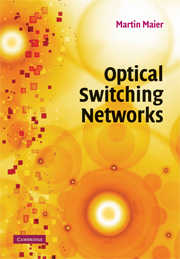Book contents
- Frontmatter
- Contents
- List of illustrations
- List of tables
- Preface
- Acknowledgments
- Part I Introduction
- Part II Optical wide area networks
- Overview
- 5 Generalized multiprotocol label switching
- 6 Waveband switching
- 7 Photonic slot routing
- 8 Optical flow switching
- 9 Optical burst switching
- 10 Optical packet switching
- Part III Optical metropolitan area networks
- Part IV Optical access and local area networks
- Part V Testbeds
- Bibliography
- Index
10 - Optical packet switching
from Part II - Optical wide area networks
Published online by Cambridge University Press: 10 May 2010
- Frontmatter
- Contents
- List of illustrations
- List of tables
- Preface
- Acknowledgments
- Part I Introduction
- Part II Optical wide area networks
- Overview
- 5 Generalized multiprotocol label switching
- 6 Waveband switching
- 7 Photonic slot routing
- 8 Optical flow switching
- 9 Optical burst switching
- 10 Optical packet switching
- Part III Optical metropolitan area networks
- Part IV Optical access and local area networks
- Part V Testbeds
- Bibliography
- Index
Summary
Optical fiber provides huge amounts of bandwidth which can be tapped into by means of dense wavelength division multiplexing (DWDM), where each fiber may carry tens or even hundreds of wavelength channels, each operating at electronic peak rate (e.g., 40 Gb/s). Given this huge number of high-speedwavelength channels, one may think that network capacity will not be an issue in future optical networks and it seems reasonable to deploy dynamic optical circuit switching (OCS) to meet future service requirements in support of existing and emerging applications. Typically, these optical circuits may be lightpaths that are dynamically set up and torn down by using a generalized multiprotocol label switching (GMPLS) based control plane to realize reconfigurable optical transport networks, leading to multiprotocol lambda switching (MPλS), as discussed at length in Chapter 5. While OCS may be considered a viable solution that can be realized using mature optics and photonics technologies, economics will ultimately demand that network resources are used more efficiently by decreasing the switching granularity from optical wavelengths to optical packets, giving rise to optical packet switching (OPS) (O'Mahony et al., 2001). Especially given the fact that networks increasingly become IP data-centric, OPS naturally appears to be a promising candidate to support bursty data traffic more efficiently than OCS by capitalizing on the statistical multiplexing gain. Furthermore, the connectionless service offered by OPS helps reduce the network latency in that OPS avoids the two-way reservation overhead of OCS. Note that in Chapter 9 we have seen that the same holds for optical burst switching (OBS) as well.
- Type
- Chapter
- Information
- Optical Switching Networks , pp. 135 - 154Publisher: Cambridge University PressPrint publication year: 2008



